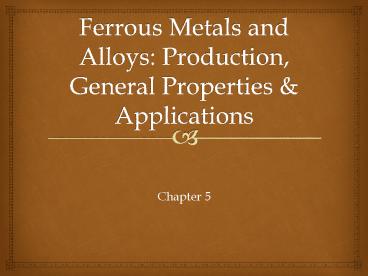Ferrous Metals and Alloys: Production, General Properties - PowerPoint PPT Presentation
1 / 15
Title:
Ferrous Metals and Alloys: Production, General Properties
Description:
Chapter 5 Among the most useful of all metals Contain iron as their base metal Carbon and alloy steels Stainless steels Tool & die steels Cast irons Cast steels ... – PowerPoint PPT presentation
Number of Views:1668
Avg rating:3.0/5.0
Title: Ferrous Metals and Alloys: Production, General Properties
1
Ferrous Metals and Alloys Production, General
Properties Applications
- Chapter 5
2
Ferrous metals and alloys
- Among the most useful of all metals
- Contain iron as their base metal
- Carbon and alloy steels
- Stainless steels
- Tool die steels
- Cast irons
- Cast steels
3
Steel (What is the definition?)
- A ferrous alloy, as simple as a mixture of iron
and carbon, but also containing a number of
alloying elements to impart various properties
4
TABLE 5.1 Applications for Selected Carbon and
Alloy Steels
5
Examples of ferrous alloy uses
- Sheet steel for automobiles, appliances,
containers - Plates for boilers, ships, bridges
- Structural steel such as I-beams, axles, bar
products, railroad ties, crankshafts - Tools, dies and molds
- Rods and wire for fasteners such a s bolts,
rivets, nuts, and staples - The average US passenger vehicle contains about
2700 lb of steel (60 of its weight)
6
Designations for steel
- AISI and SAE designate carbon and alloy steels
using 4 digits. - The first two digits indicate the alloying
elements and their percentages - The last two digits indicate the carbon content
by weight - ASTM has another designation system
7
UNS (Unified Numbering System) is the present
system
- Letter gives the general class of alloy
- G- ANSI and SAE carbon steels
- J- Cast steels
- K-Miscellaneous steels and ferrous alloys
- S-stainless steels
- T-tool steels
- 5 digit number gives chemical composition
8
Carbon Steels
- Classified by their proportion (by weight) of
carbon content - Low-carbon steel or mild steel (lt.30 Carbon)
- Medium-carbon steel (0.3ltCarbonlt0.6)
- High-carbon steel(gt0.6 Carbon)
- Resulfurized carbon steels
- Alloy steels steels containing significant
amounts of alloying elements
9
TABLE 5.2 Typical Mechanical Properties of
Selected Carbon and Alloy Steels
10
Stainless Steels
- Corrosion resistance
- High strength
- High ductility
- High chromium content
- They are called STAINLESS because, in the
presence of oxygen (air), they develop a thin,
hard, adherent film of chromium oxide that
protects the metal from corrosion.
11
TABLE 5.5 Mechanical Properties and Typical
Applications of Selected Annealed Stainless
Steels at Room Temperature
12
Tool and Die Steels
- Specially alloyed steels designed for
- High strength
- Impact toughness
- Wear resistance at room elevated temperatures
- Used in forming machining metals
13
TABLE 5.6 Basic Types of Tool and Die Steels
14
TABLE 5.7 Processing and Service
Characteristics of Common Tool and Die Steels
15
TABLE 5.8 Typical Tool and Die Materials for
Metalworking Processes































